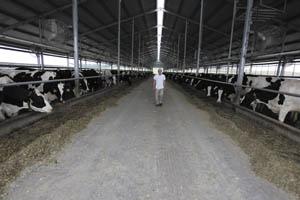The Dairy King
Published 12:00 am Tuesday, September 5, 2006

- Photo by Joshua McCoyAdam Robey, a fifth generation farmer, surveys dozens of cattle Friday morning at his family's farm in Logan County. About 1,100 cattle are milked daily on the farm.
The April-to-June U.S. all milk price this year nearly scraped an average of $12 per hundred weight, which was the worst quarter since the second quarter of 2003, according to the U.S. Department of Agriculture’s mid-year cattle report.
Last month, the Kentucky Department of Agriculture bestowed awards on some of the dairy farmers in southcentral Kentucky in a time of low dairy prices that burden their bottom lines.
More than 175 dairy farmers and processors gathered at the state fair for the recognition dinner sponsored by Dairy Products Association of Kentucky, the Kentucky Dairy Development Council and the KDA.
There, Robey Farms of Adairville in Logan County became the state’s first Dairy Production Award winner, taking top honors in the competition with an average weight of milk of more than 29,000 pounds that their herd produces in a year.
“This has been an extremely difficult year for dairy farmers across Kentucky because of low (dairy) prices and it’s always good to have an award like this that will offer some hope and optimism for the future,” said Roger Thomas, executive director of the Kentucky Dairy Development Council.
For the KDDC, a new organization less than two years old, the awards were perfect timing. “Our board of directors felt it was important to let everyone know that we have dairy producers in Kentucky that do a very good job of achieving high quality production,” he said. “They felt the dairy recognition dinner would be a wonderful opportunity to showcase those dairy producers from around the state.”
Lee and Denise Robey and their three sons milk more than 900 cows.
Adam Robey gets up at 5:30 a.m. most days to check on cows, do paperwork and make sure everything is running smoothly on the farm his father and mother, Lee and Denise, brothers Chris and Eli, uncle Carr Robey and grandparents D.L. and Jane Robey help tend.
“Our mom takes care of the baby calves up to almost 2 years old,” he said. “We’re trying to make a good safe product for the consumer as well as being environmentally friendly while trying to be good to the cows – the animals – and give them the best life that they can have.
Most farms around the Robeys have about a 100 cows.
“Most people think that just because we have 1,000 cows that we’re living high on the hog,” Adam Robey said. “But dairy farmers get up early just like everyone else.”
The Robey Farm dates back to 1899 and the award gives the Robey family a sense of pride to be honored.
Three years ago, the Robeys built a new production facility from scratch, which houses 1,100 cows.
“That’s the main reason we’ve got a good production,” Adam Robey said. “It’s good to know building a new facility is making a difference.”
The old facility is still used for their “dry calves,” which spend 10 months being milked and two months resting.
Like more and more aspects of agriculture, the trend with the dairy industry is toward larger farms as pressure from low milk prices take a toll on smaller farmers, something Adam Robey said his family tries to deal with.
“We try to operate where we can survive on low milk prices and still make a profit and when prices are better we reinvest more in our operations,” Adam Robey said.
Dr. George Hershey is an extension dairy specialist for the University of Kentucky and a member of the Kentucky Milk Producers Association (KMPA).
Hershey said in addition to the usually long days and hard work, Kentucky dairy farmers are facing continual financial challenges with the price of milk being low.
But Hershey said Kentucky’s dairy farmers have succeeded at practicing sustainable agriculture before that became a popular buzzword.
Hershey said milk prices are contingent on the nation’s supply and demand.
“We’re at the low part of the cycle,” he said. “It was pretty good last year.”
But Hershey said it’s still a tight market.
“We don’t have a big surplus of milk and milk is a perishable product,” he said. “It can’t sit in a warehouse for someone to wait and buy.”
The Elkins Dairy of Warren County, with David and Donald Elkin, the farm of Bonnie and David Sammons in Hart County, and Ken Mattingly’s family farm in Barren County took home district production awards.
In a report, Kenny Burdine, an agriculture economist for the University of Kentucky said even though milk prices were “disappointing” in the first half of 2006, the “U.S. dairy herd is likely to see an increase in cow numbers in 2007.”
Burdine said that increase could add to existing pressures on dairy prices and that consumers will need to drink and eat more dairy products for producers to see better prices next year.
– For more on Kentucky’s dairy industry, visit http://www.kyagr.com or call the Kentucky Department of Agriculture at (502) 564-6676, ext. 247.
Short&Simple
—Kentucky’s dairy industry is 20th in the nation with 110,000 dairy cows.
—Kentucky produced 1.423 billion pounds of milk in 2004, down 3 percent from 2003.
—Average production per cow was 12,936 pounds in 2004.
—2,300 Kentucky farms had dairy cows in 2004, down from 2,500 in 2003.
—Cash receipts from milk marketing in 2004 was $236.6 million, up 23 percent from 2003.
—Top milk producing counties in 2004 were Barren, with an estimated 133.2 million pounds; Adair, 85 million; Fleming, 63.2 million; Logan, 61 million, and Marion, 59.6 million pounds.
—Warren County produced an estimated 53.3 million pounds.
—The top five counties in number of milk cows as of Jan. 1, 2005, were Barren, 10,000; Adair, 7,900; Fleming, 5,100; Metcalfe, 4,700, and Lincoln, 4,200.
– Source: The National Agricultural Statistics Service






